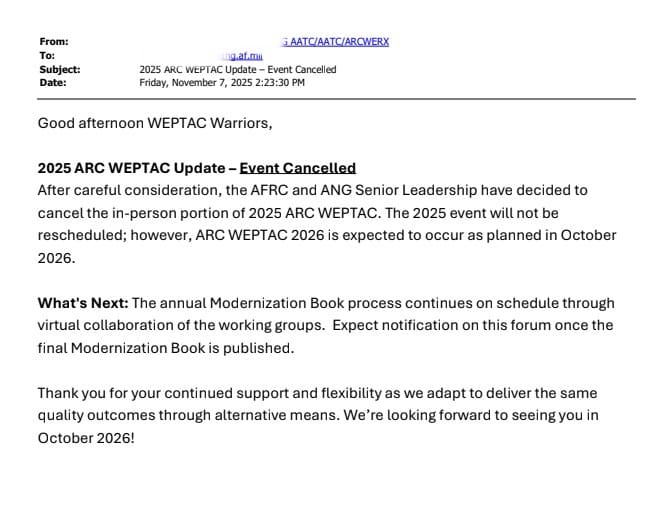
WEPTAC / AFSPECWAR will be held Jan 14-15 at Nellis AFB. Open to all military personnel, you’ll meet over 50 of the best companies industry has to offer.

WEPTAC / AFSPECWAR will be held Jan 14-15 at Nellis AFB. Open to all military personnel, you’ll meet over 50 of the best companies industry has to offer.
The Air Force has cancelled the 2025 Reserve Component WEPTAC Conference but plans to reconvene in person during their normally scheduled meeting in October 2026.

Consequently, the MAG Exchange event is also postponed until Fall of next year. Please update your schedules accordingly.
Chapman Training Annex, Texas — The Special Warfare Training Wing (SWTW) marked a historic milestone today as it launched the first-ever Zulu Course, a groundbreaking common skills training program uniting Air Force Special Warfare (AFSPECWAR) career fields under one standardized curriculum.
The Zulu Course is aimed at aligning common training standards across Combat Control, Pararescue, Tactical Air Control Party, Special Reconnaissance, and their respective officer careers. By consolidating critical early-stage training, the course strengthens interoperability among AFSPECWAR Airmen and enhances mission readiness for global operations.
“This course is the result of deliberate data-driven analysis and a shared commitment to producing the world’s most capable operators,” said Lt. Col. Benjamin Schmidt, Director of Plans and Policy for the SWTW. “The Zulu Course establishes a shared foundation for our operators from day one, ensuring graduates leave here with the same core skills, knowledge base, and mindset.”
Held at the Chapman Training Annex in San Antonio, Texas, the Zulu Course brings together skillsets that were previously taught at multiple locations into a single, cohesive program that’s focused on the basic skills of shoot, move, communicate, casualty care, weapons, advanced insertion/extraction skills, individual skills, and small team operations. The course is taught by instructors with operational experience across the AFSPECWAR enterprise, combining expertise from multiple career fields to deliver holistic training.
The name “Zulu” was chosen as based off the Air Force Specialty Code (AFSC) system. Zulu is the phonetic alphabet code that denotes an AFSPECWAR Airmen, with the enlisted code being 1Z and the officer code being 19Z.
“This is a defining moment not just for the Wing, but for the future of Air Force Special Warfare,” said Col. Kaveri Crum, commander of the SWTW. “A tremendous amount of time and effort has gone into making the Zulu Course a reality. I could not be prouder of this team.”
The inaugural class will spend 16 weeks mastering the common skills curriculum before moving on to their respective advanced training courses. The lessons learned from this first iteration will help refine future courses to better deliver the skills that the operational field requires.
With the launch of the Zulu Course, the Special Warfare Training Wing continues to assess, select, and train, now with an even stronger and more unified foundation.
Story by 1st Lt Casen Salitore, Special Warfare Training Wing

Due to the government shutdown, ARC WEPTAC and M.A.G. Exchange are shifting from October 20-21 to December 7-8 at the Hilton DoubleTree Hotel-Tucson Airport.

We’re about a month away from the first MAG Exchange in Tucson. The focus is on ANG and AFRC ground combatants who are attending WEPTAC.

The premier Manufacturers Advisory Group (MAG) Exchange will be held this Oct 20-21 in Tucson at the Four Points Sheraton, 5 to 10 pm.
Dates coincide with the ARC WEPTAC.
Target audience is the ground combatant elements of Air Force as well as federal, state and local law enforcement.
Vendors can contact MAG Exchange via IG @magexchamgemil
The 330th and 331st Recruiting Squadrons, teamed up to host an Athletic Leadership Boot Camp at 17 Springs Complex, Millbrook, Alabama, July 18, 2025. The ALB featured teamwork-focused drills designed to build strength, resilience and camaraderie. Exercises included navigating with blacked-out goggles, sandbag sled pulls and a sandbag walk across the end zone. Staff Sgt. Andrew Hestley, 330th Recruiting Squadron special warfare scout, emphasized the importance of teamwork and physical fitness in preparing recruits for the challenges of Special Warfare. (U.S. Air Force video by Airman 1st Class Nelvis Sera)

We’re less than 90 days out from the first Manufacturers Advisory Group (MAG) Exchange this Oct 20-21 in Tucson.
Location is the Four Points Sheraton, 5 to 10 pm.
Dates coincide with the ARC WEPTAC.
Target audience is the ground combatant elements of Air Force as well as federal, state and local law enforcement.
Vendors can contact MAG Exchange via IG @magexchamgemil